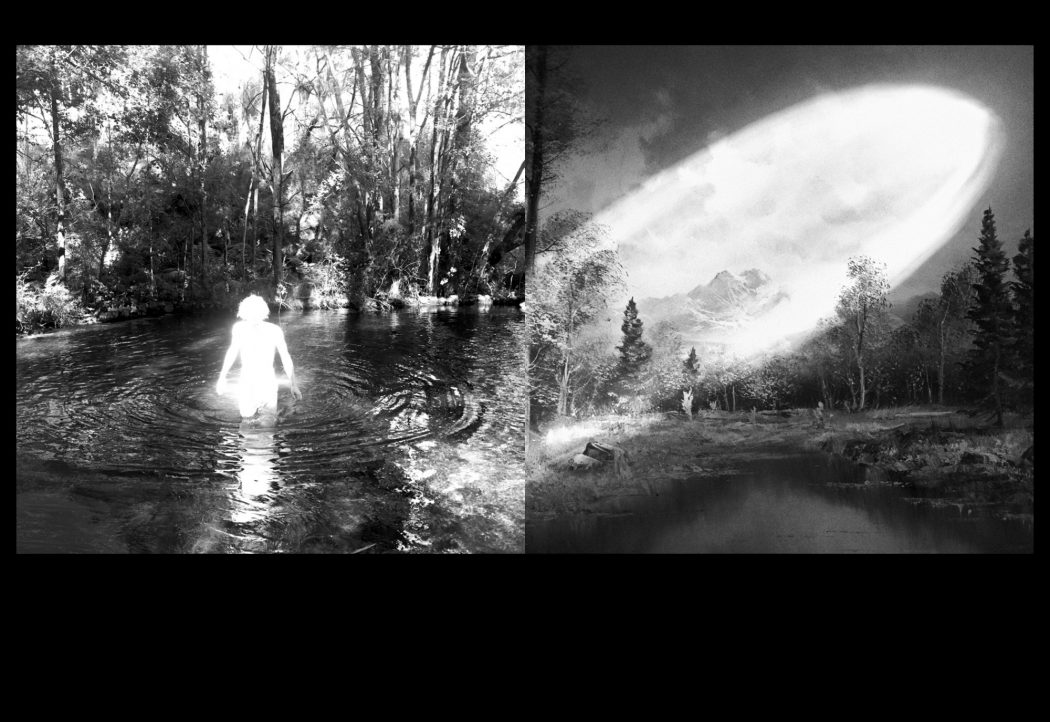What do we do with black and white these days? Photographers can of course still shoot film, process it, print it; they can chase masters such as Garry Winogrand and Bruce Davidson as if it’s still forty, fifty years ago. But if a photographer wants to bring black and white into the current century—modernize it, exploit all the current possibilities—then what to do?
One approach that caught me at last year’s New York Art Book Fair was Antony Cairns’s LDN EI, in which he put his high-contrast black-and-white images on a hacked Kindle. Clicking through the “book,” you saw less a photo and more an arrangement of tones. I bought the Kindle version of LDN EI (still available), yet passed on the printed version—it wasn’t as interesting, not as pure an experience.
One exciting thing about Katrin Koenning and Sarker Protick’s Astres Noirs is that it brings experiment and new technology in black and white back into a physical, bound book—indeed, one of those photobooks that could only be an actual book. But what intrigues me most about Astres Noirs is that in a way it understands that it’s not black-and-white photography at all, but something else instead.
You get a clue to what’s going on as you open the book and find the words “All colours … within black.” Then you realize that half-hidden under a folded sheet is the word disappear, so the phrase reads, “All colours disappear within black.” And that’s what Astres Noirs is: a book of photos in which the colors have been removed. We call it black and white (or, as we’ll see, more accurately black and silver) because that’s what we’re used to, but in truth the book is onto something else. Just look at the title: In English, Black Stars. This book is not called Black Holes. Light and form do not disappear but instead shine forth, but mysteriously, ambiguously, contradictorily.
Astres Noirs was conceived, edited, and published by Chose Commune out of Paris. Cécile Poimboeuf-Koizumi and Vasantha Yogananthan had been following two photographers on Instagram, liked their work, saw similarities, and asked them for a Dropbox account’s worth of photos to be made into a book.
For their part, Koenning and Protick had been shooting on their smartphones (presumably in color, shots then drained of color), Koenning from Australia, Protick from Bangladesh. Many of their photos are of commonplace things, a puddle, a horse, a bird. Some are more mysterious, more telling: a soft ball of light, a floating body, specks through an airplane window, faces nearly lost to the shiny blur.
Now I’m always keen on photographs—by definition, representational art, since a person has to actually be somewhere and record a picture with some form of device—that do not reveal exactly what they are. Such uncertainty is often the case here, but I’ll also suggest that what the photos are literally depicting, even if clear, is of minimal interest. What truly matters is the way the shots come to us—the way the work’s been constructed.
The book itself is a standard size, six-by-nine inches, and is comprised of black sheets of paper, each of which is folded at the top. Thus, a page is closed at the top and at the book’s center, where it’s bound in; but each sheet is also open at the far edge and the bottom, which gives each page both the thickness of two sheets, and, more important, a hidden area between that, by judicious lifting, can be looked at. These semi-hidden pages are put to intriguing use; photos are sneaked in from time to time. Separate a folded page, there might be a glimpse of a transitional shot, a kind of harmony note.
What else is singular in Astres Noirs is the way the printing technique (from Cassochrome, in Belgium) paints each black sheet of paper with silver ink. The effect is nothing like a black-and-white darkroom print. Indeed, the intensity of light on the page reminds me of the original 1933 gravure printing of Brassai’s Paris du Nuit, in which the pages truly glow. (Get yourself to a library with a first-edition copy; you won’t believe it.)
Pages light up in Astres Noirs, too; some more than others, but that’s good. At times the book wants the subtlety of a classic print and its near infinite range of tones, and Cassochrome pretty much delivers. But when the book wants the image on the page to simply shine, it does that, too. The printing is always interesting, always alive. And the photos, even if just a flickering of light spots across the black page, all hold together. The experience of the book is a unity, one thing.
A photobook that truly works should be as captivating as a fine piece of music—a triumph of form, theme, movement, instrumental coloration, and, of course, the passion of the playing.
What we have here reminds me most of a late Beethoven string quartet: dark, intense, moody, powerful, and all of a piece. So large credit to the quartet behind Astres Noirs: two photographers, two editor/publishers (and a masterful print shop) who have all come together to play this photobook so well.
Astres Noirs can be purchased here.
Robert Dunn is a writer, photographer, and teacher. His novels include Meet the Annas and Stations of the Cross. His photobooks OWS, Angel Parade, and Meeting Robert Frank are in the permanent collection of the International Center of Photography (more info here). In Spring 2017, Dunn will teach a course called “Writing the Photobook” at New School University in New York City.






